How You Can Use Serpstat Search Suggestions Tool: Tips And Tricks


Yuliia Zadachenkova
Product Marketer Serpstat
We've recently updated the long-familiar to users "Search suggestions" function. What is the update, how to use the new features of this function and the secret script for choosing effective keywords. We will tell you in this article.
What are the "Search suggestions" in Serpstat?
Search questions are variations of the suggestions in the form of questions that pop up when you enter a keyword into the search bar.

Serpstat Google keyword suggestion tool shows all possible search suggestions that include question and looks for it in real time.
All search suggestions are contained in the section "Keyword research" - "SEO research". Just enter a keyword and go to the desired section:
All search suggestions are contained in the section "Keyword research" - "SEO research". Just enter a keyword and go to the desired section:
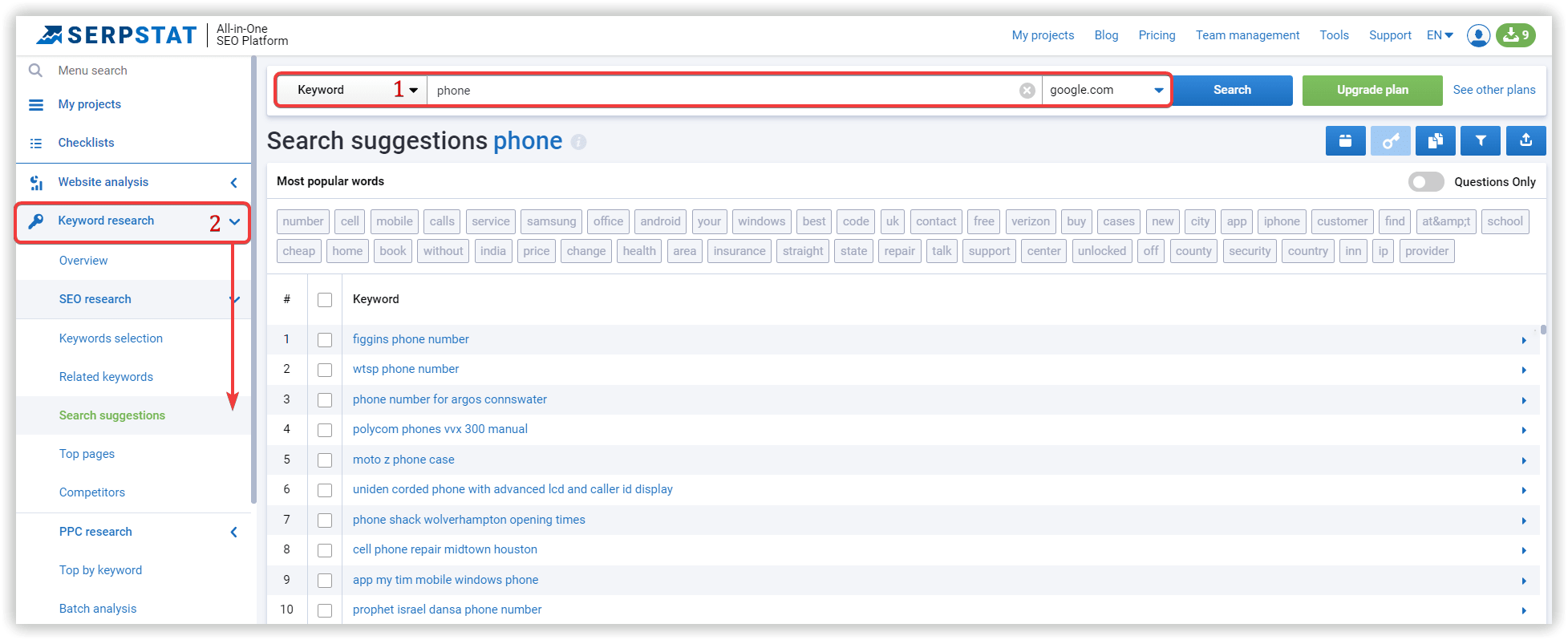
In order to find out search suggestions as questions, choose "Questions only" in the report:
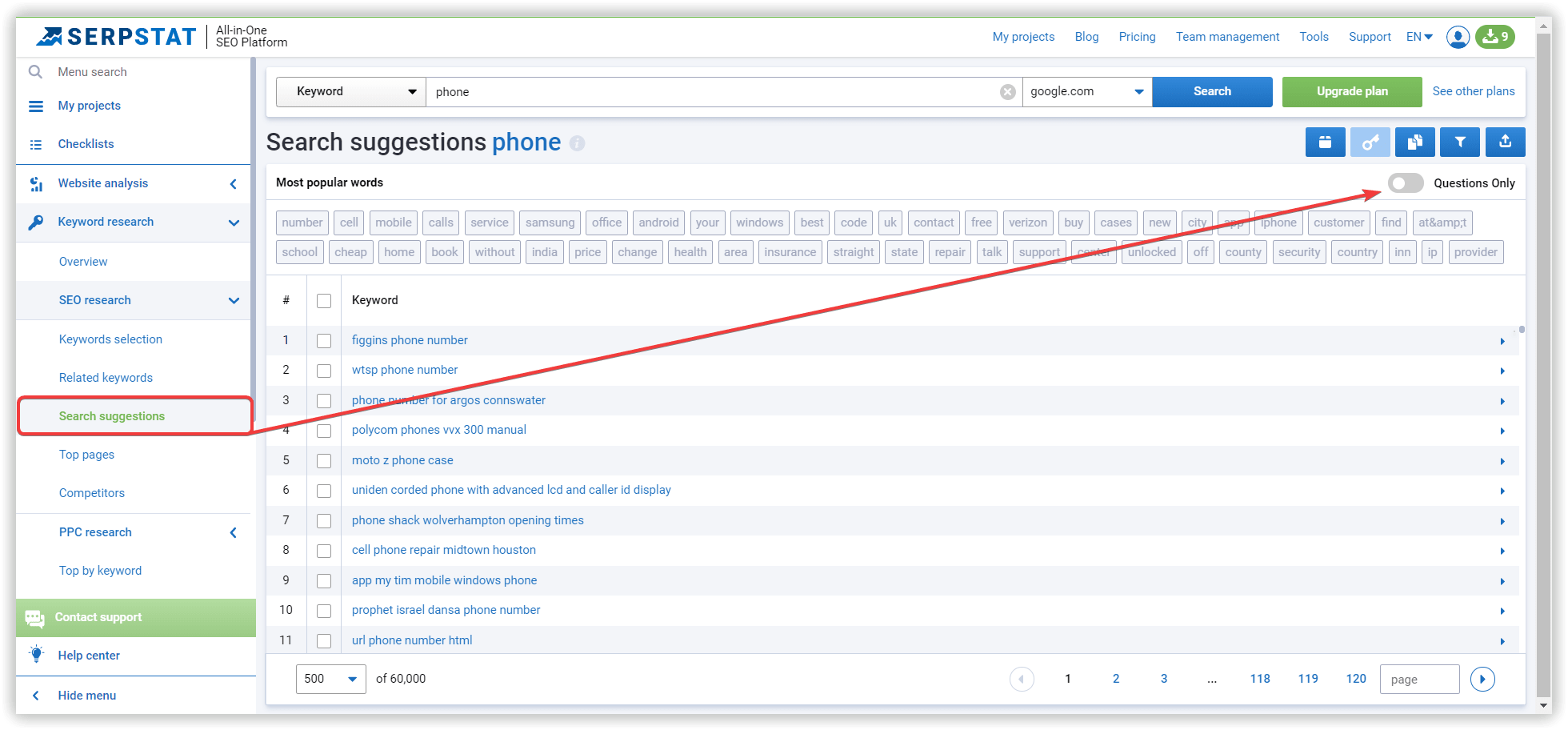
How we improved the "Search suggestions" tool?
Now our users are able to see not just a list of questions, but their breakdown by specific categories: the most popular words and types of question words.
Here is an example. Let's say we want to find search questions for a keyword "phone" (let's imagine that we make a plan for the content for the blog of the online shop).
We enter the keyword, then select the region (let it be google.com), click on "Search" and go to the already mentioned section "Search suggestions" — "Questions only".
Here is an example. Let's say we want to find search questions for a keyword "phone" (let's imagine that we make a plan for the content for the blog of the online shop).
We enter the keyword, then select the region (let it be google.com), click on "Search" and go to the already mentioned section "Search suggestions" — "Questions only".
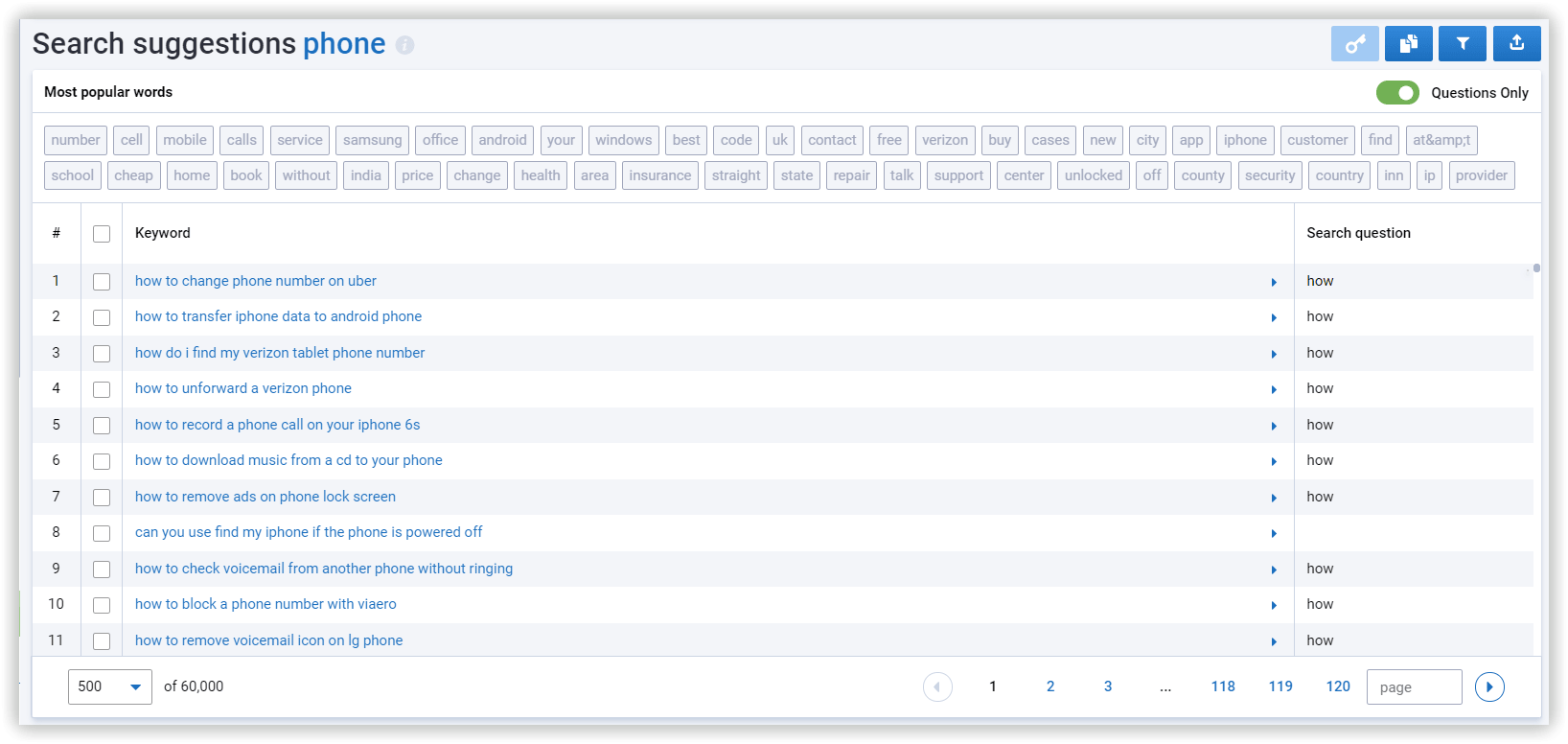
Serpstat has found about 60 000 questions, which can already be used as topics or titles for articles, or even ideas for you YouTube video. Now let's see what we get in this report:
Personal demonstration
Leave a request, and we will conduct a personal demonstration of the service for you, provide you with a trial period, and offer comfortable conditions for starting exploring the tool
1. "Most popular words" block
In this block you can see the most used words from the questions found by Serpstat. When you click on one of these words, it is automatically added to the initial request and you will find a search questions with the use of this phrase. For example, if you click on "code", Serpstat will find suggestions for the keyword "phone code".
Let's see how it works:
Let's see how it works:
We get 3 957 words with usage of phrase "phone code", that you can see at the report just above.
2. Keyword operations
One more cool function is adding keywords from this very report directly to the Rank tracker. For this you need:
- Choose desired keywords;
- Click on the "Keyword operations" button;
- Choose a project where you'd like to add these keywords;
- Press "Submit".
Here you can get the whitepaper to boost your skills in keywords researching:
3. Copy to clipboard
Another time-saving function is copying keywords to clipboard. To do this, follow these steps:
- Choose the desired keywords via the checkbox;
- Click on the "Copy to clipboard" button and choose the necessary info to copy.
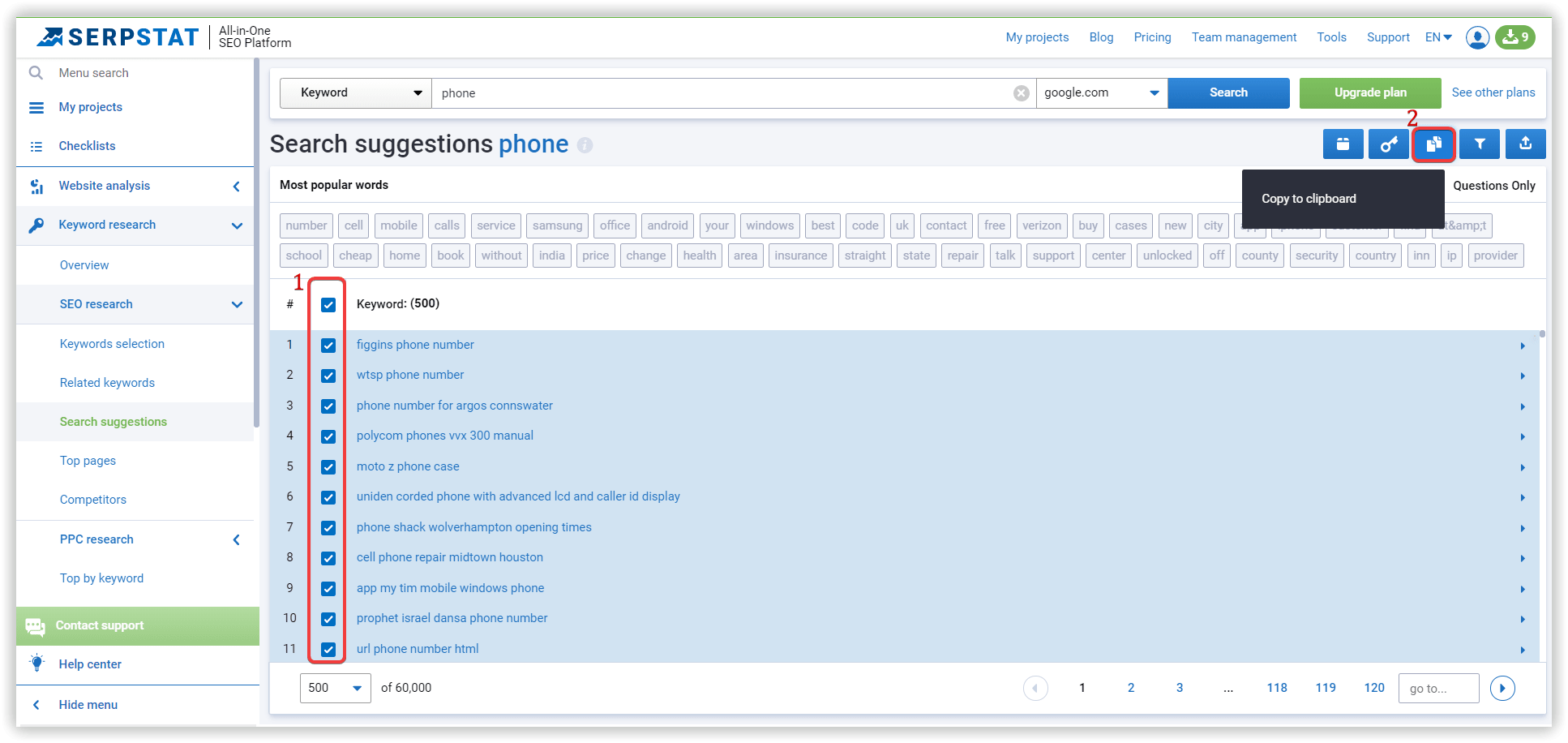
4. Filtering
To get visually appealing report, you can filter keywords under search questions. For example, you want to write an article "How to unlock the phone without a code".
- Click on the filter;
- Choose the "how" question word;
- Apply the filter.
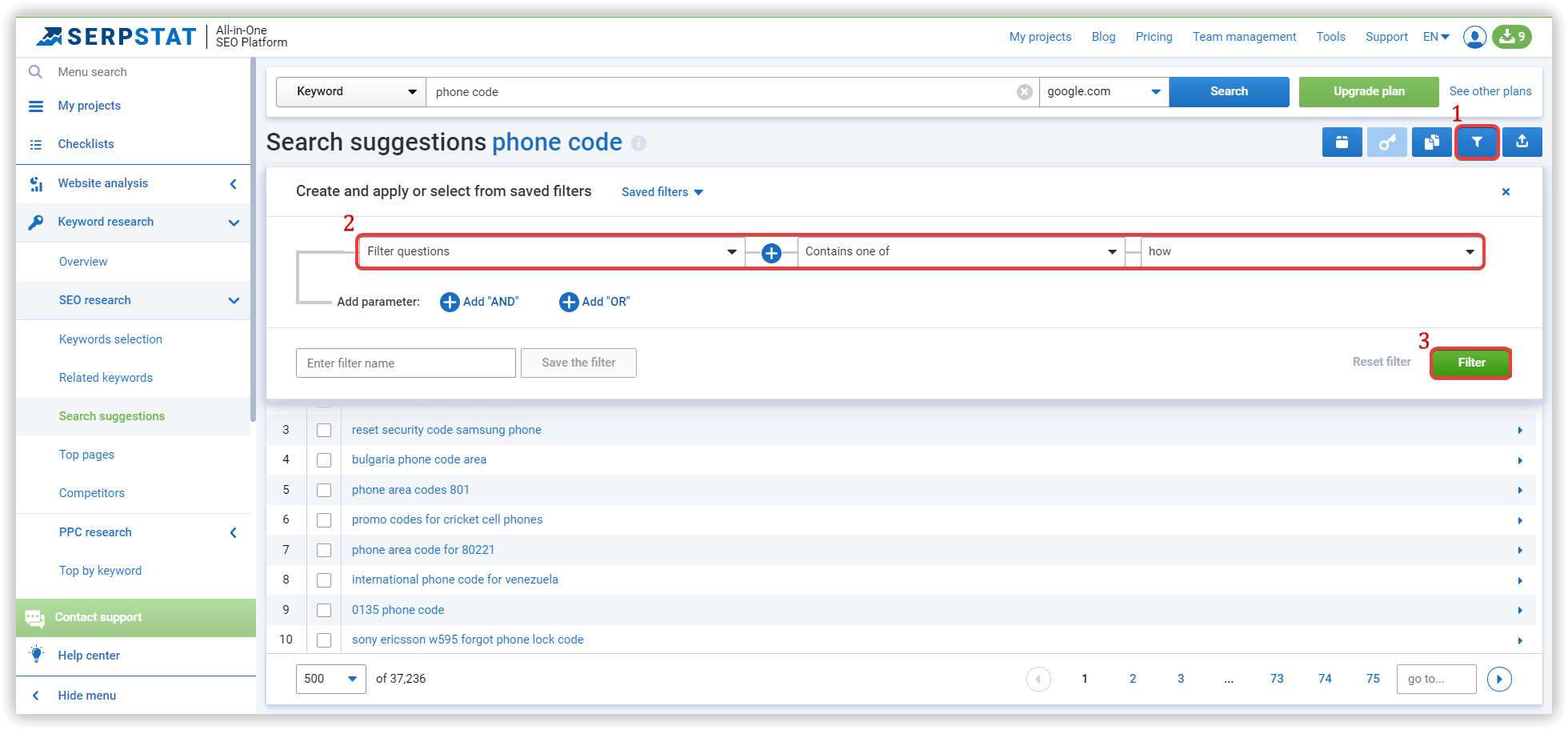
Now you have the variations of the phrase which can be added to your content.
How to choose effective keywords: secret script for you!
Note!
Previously, Serpstat supported API version 3 with GET parameters but now uses API version 4 with POST parameters—the difference between GET and POST lies in the data transmission method. A GET request transfers data in the URL, while a POST request transfers data in the request's body.
These differences determine the properties of the methods and the specifics of requests for using either method. You can use the case example as an example of the possibilities for writing your scripts or modifying existing ones to accomplish your goals.
You can familiarize yourself with the current API methods and syntax here: https://serpstat.com/api/
POST-example:
Previously, Serpstat supported API version 3 with GET parameters but now uses API version 4 with POST parameters—the difference between GET and POST lies in the data transmission method. A GET request transfers data in the URL, while a POST request transfers data in the request's body.
These differences determine the properties of the methods and the specifics of requests for using either method. You can use the case example as an example of the possibilities for writing your scripts or modifying existing ones to accomplish your goals.
You can familiarize yourself with the current API methods and syntax here: https://serpstat.com/api/
POST-example:
{
"id": "1",
"method": "SerpstatDomainProcedure.getDomainsInfo",
"params": {
"domains": ["nike.com", "adidas.com"],
"se": "g_us"
}
}
SEO expert at Netpeak Group, Dmitriy Mazuryan, shares his script and tells how it works. This script aims to help content writers save their time spent on collecting relevant keywords.
How does it work?
The script's algorithm is based on:
You give "weight" to these keywords to get results even if Serpstat and Google find nothing.
Here is how script processes keywords:
1. The script grabs some keywords and determines their "weight" according to their search volume. The higher search volume the keyword has, the more "weighty" it is. Then the script sums the search volume of keywords, where the required word/phrase is mentioned.
Search volume for search suggestions is "5". Moreover, "bad keywords" or exclusions, which you enter manually to the script, are also taken into account.
2. Then it grabs 2-word phrases and determines their "weight". The words in phrases are sorted by the alphabetic order to speed up the process.
3. Finally, script combines the newly gained data with that received at the previous sessions.
- Google Keyword Suggestions
- API Serpstat (you can find your API token at your profile)
- Script collects the keywords from Serpstat's database
- Then it collects search suggestions from Serpstat's database
- Finally, it collects search suggestions from Google's suggestions
You give "weight" to these keywords to get results even if Serpstat and Google find nothing.
Here is how script processes keywords:
1. The script grabs some keywords and determines their "weight" according to their search volume. The higher search volume the keyword has, the more "weighty" it is. Then the script sums the search volume of keywords, where the required word/phrase is mentioned.
Search volume for search suggestions is "5". Moreover, "bad keywords" or exclusions, which you enter manually to the script, are also taken into account.
2. Then it grabs 2-word phrases and determines their "weight". The words in phrases are sorted by the alphabetic order to speed up the process.
3. Finally, script combines the newly gained data with that received at the previous sessions.
How to use this script?
To make script work correctly, it's preferable to fill all input boxes. But not all of them are required.
Limit the maximum number of phrases from the organic issue, which will participate in the analysis. You cannot set more than 1000 here.
০ Format: type, keyword, "weight". Every keyword should be written from a new line.
০ Types:
w — one word
p — two words
Examples:
"w; bottle; 50" — initial weight of word bottle is 50.
"p; plastic bottle; 30" — initial weight of phrase plastic bottle is 30.
"w; plastic bottle; 20" — incorrect. You cannot use a two-word phrase for the "w" type.
- Keyword — required keyword
- Search Engine — a search engine for which the analysis will be carried out. For example, for the US Google, you need to set the g_us. The entire list of available search engines can be found here.
Limit the maximum number of phrases from the organic issue, which will participate in the analysis. You cannot set more than 1000 here.
- Default keys — list of two-word keywords. You should give each of them some "weight" to receive some kind of result if something goes wrong.
০ Format: type, keyword, "weight". Every keyword should be written from a new line.
০ Types:
w — one word
p — two words
Examples:
"w; bottle; 50" — initial weight of word bottle is 50.
"p; plastic bottle; 30" — initial weight of phrase plastic bottle is 30.
"w; plastic bottle; 20" — incorrect. You cannot use a two-word phrase for the "w" type.
- Bad words — comma-separated list of words you want the script to exclude from the results.
- Token — here you need to enter your token for API access. It can be found on your profile page.
How to use the gained results?
The first 10 phrases after "RESULT" are keywords that are desirable to use in the text. Other 20 are up to you.
Don't use unreadable word forms offered by the script. Change the word order, add prepositions to make them readable.
You should understand that the gained results are just a bunch of words so that you can change the order of words in phrases and add prepositions to make them readable. For example, you can use "free backlinks checker" instead of "backlinks checker free". Or "backlinks with high pr" instead of "backlinks high pr".
It happens because the words are sorted by the alphabetic order for faster-obtaining data.
If you have some doubts that the gained results are not correct or there are some problems with the default settings, you can look at the list of the words and phrases that were used in parsing. Click on "Show more" at the very end of the page. See the example in the second picture below.
Don't use unreadable word forms offered by the script. Change the word order, add prepositions to make them readable.
You should understand that the gained results are just a bunch of words so that you can change the order of words in phrases and add prepositions to make them readable. For example, you can use "free backlinks checker" instead of "backlinks checker free". Or "backlinks with high pr" instead of "backlinks high pr".
It happens because the words are sorted by the alphabetic order for faster-obtaining data.
If you have some doubts that the gained results are not correct or there are some problems with the default settings, you can look at the list of the words and phrases that were used in parsing. Click on "Show more" at the very end of the page. See the example in the second picture below.
Tips on how to use these keywords
- Include these keywords in H1, Title, and Description;
- Add keywords to the image alt tag;
- Integrate keywords into content naturally;
- Don't highlight all keywords in bold;
- Don't use too many keywords;
- Create useful and interesting content for these keywords.
Here is how the script looks:
P.S.
As tradition requires, we share this script with you. You can use online version:
Or you can download the source code:
API Serpstat: collecting semantics
Do you want to collect semantics even faster by uploading more massive data? Then don't forget about our API! With its help, you can work with both "Related keywords" and "Search suggestions".
Methods save time on expanding semantics and allow you to work with a lot of information. And also, you don't even need to go into the Serpstat interface for this :)
Here is an example of a request and response for the "Search suggestions" method:
Methods save time on expanding semantics and allow you to work with a lot of information. And also, you don't even need to go into the Serpstat interface for this :)
Here is an example of a request and response for the "Search suggestions" method:
{
"id": 1,
"method": "SerpstatKeywordProcedure.getSuggestions",
"params": {
"keyword": "phone",
"se": "g_us",
"page": "1",
"size": "3"
}
}
{
"id": "1",
"result": {
"data": [
{
"keyword": "figgins phone number",
"geo_names": []
},
{
"keyword": "wtsp phone number",
"geo_names": []
},
{
"keyword": "phone number for argos connswater",
"geo_names": []
}
],
"summary_info": {
"page": 1,
"total": 2428229,
"left_lines": 999487
}
}
}Personal demonstration
Our specialists will contact you and discuss options for further work. These may include a personal demonstration, a trial period, comprehensive training articles, webinar recordings, and custom advice from a Serpstat specialist. It is our goal to make you feel comfortable while using Serpstat.
If you have any questions about any about our service, feel free to ask them in the comments under this article or contact our Customer Success team.
Join us on Facebook and Twitter to follow our service updates and new blog posts :)
Join us on Facebook and Twitter to follow our service updates and new blog posts :)
Speed up your search marketing growth with Serpstat!
Keyword and backlink opportunities, competitors' online strategy, daily rankings and SEO-related issues.
A pack of tools for reducing your time on SEO tasks.
Found an error? Select it and press Ctrl + Enter to tell us
Recommended posts
Cases, life hacks, researches, and useful articles
Don’t you have time to follow the news? No worries! Our editor will choose articles that will definitely help you with your work. Join our cozy community :)
By clicking the button, you agree to our privacy policy.
Are you sure?
Thank you, we have saved your new mailing settings.
Report a bug
